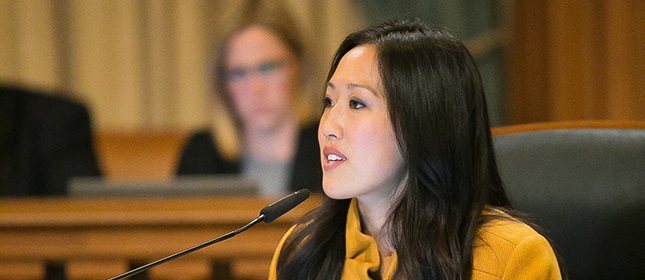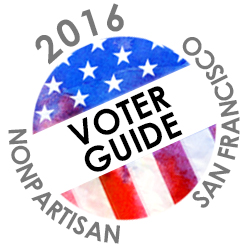Almost every San Francisco mayor since Harry Truman was president has appointed at least two supervisors while in office, affecting politics long after their own terms ended. On Nov. 8, voters will decide if they want that trend to end.
Proposition D would limit a mayor’s power to fill vacancies in elected offices, most notably the Board of Supervisors, shifting control to the voters. Backed by incumbency, mayoral influence and a network of donors, appointed supervisors have had a nearly 80 percent success rate in retaining their seats after their interim terms conclude. Expectations are that appointees will carry political water for the mayor.
There is little surprise then that opposition to the ballot measure is led by four of five former mayors, all Democrats. They were responsible for placing 19 people — two had been elected already — onto the Board of Supervisors between 1978 and 2010, before Mayor Ed Lee came to office.
“Proposition D sounds appealing, but it will really result in costly special elections and the installation of temporary ‘caretaker’ Supervisors who have NO accountability to their constituents for the time they are in office,” says the official opposing argument. “Please join us, along with former Mayor and Lieutenant Governor Gavin Newsom, in opposing Proposition D.” The signers are former mayors U.S. Sen. Dianne Feinstein, Willie Brown Jr. and Frank Jordan. They are joined by Angela Alioto, a former president of the Board of Supervisors, the daughter of former Mayor Joe Alioto and a failed mayoral candidate.
But Larry Bush, who was special assistant to Mayor Art Agnos during his term from 1988 to 1992, said the former mayors might have another reason for their opposition.
“Each of the mayors who oppose Prop. D have enough influence with Ed to appoint someone they like,” he said, referring to Lee. “These mayors are looking for someone who owes them.”
Agnos is the only ex-mayor who supports Proposition D. He was an anomaly during his one term, from 1988 to 1992: he did not appoint a single supervisor, the only mayor in 38 years who did not.
Lee, who so far has made three interim appointments to the board, rose to power through a series of appointments going back to the late 1980s. He has taken no official position on Proposition D. But, according to the San Francisco Chronicle, he views it as a “power grab,” and two of Lee’s chief advisers, Tony Winnicker and Ace Smith, are on leave to fight Proposition D and three other ballot measures that would take powers away from the mayor’s office.
If it passes, Proposition D would have immediate impact on today’s Board of Supervisors, whose 11 members often struggle to pass legislation because neither the so-called progressive nor moderate factions can easily pull together the necessary votes. Lee has a chance to make his fourth appointment after either supervisor Scott Wiener or Jane Kim is elected to replace termed-out state Sen. Mark Leno.
And because six other seats are also up for grabs, the legislative body could look completely different following this election, and it is anybody’s guess how crucial that appointee’s vote will be to tipping the new political balance.
Accountability to voters
Though he never served as a supervisor, Lee exemplifies the power of appointments, having several former mayors to thank for his political career, starting with Agnos. He made Lee the first investigator for the city’s Whistleblower Ordinance, and later deputy director of human relations. Next, he served as executive director of the San Francisco Human Rights Commission under Agnos, Jordan and Brown, who later put him in charge of city purchasing.
But it was Newsom — whom Brown appointed to the Board of Supervisors — who set up Lee for his eventual ascent to the mayor’s office. In 2005, a year after being elected mayor, Newsom appointed Lee as City Administrator and reappointed him to a second five-year term in 2010. That November, Newsom was elected lieutenant governor, and in January 2011, after political maneuvering, the Board of Supervisors appointed Lee to fill out the remaining year of Newsom’s term after he promised not to stand for election. Lee later reneged on that promise, and in November 2011 he became the city’s first elected Asian mayor.
District 11 Supervisor John Avalos wrote this year’s Proposition D in an effort to give voters a bigger voice in choosing their local representatives. In addition to the supervisors, Proposition D would also apply to these elected offices: Assessor-Recorder, City Attorney, District Attorney, Public Defender, Sheriff, Treasurer, the Board of Education and the Community College Board of Trustees.
Under the proposed law, a mayor could appoint a temporary replacement within 28 days — currently there is no time limit — but the appointee would serve a maximum of six months, except in special circumstances. If a regular election was not scheduled within six months, a special election would then be called to fill the remainder of the term. The mayor’s pick would not be allowed to run in that election but could in the following one.
Avalos, who is being termed out this year, spent years crafting the legislation. He first proposed a version that failed to make it onto the 2014 ballot, and that was in response to Lee’s decision to seek election rather than step aside.
Sometimes using Lee as an example, Avalos has argued that appointees’ brief stints in office give them the unfair advantages of increased name recognition and access to donors, enabling them to easily defeat the competition in subsequent elections and remain in power.
The data appear to bear this out. Out of all the supervisors appointed since 1948, 78 percent were subsequently elected. Since 1978, that figure is 75 percent.
But if the appointment power is indeed a tool for influencing politics for years to come, then recent mayors have wielded it with varying degrees of success, and Lee himself has largely failed.
Feinstein appointed six supervisors while mayor during 1978-1988, and five won election when their appointments concluded. Jordan appointed two supervisors while in office from 1992 to 1996, and one retained her seat. All but one of Brown’s six appointments were elected. Newsom appointed three people before leaving office in 2011, and all retained their seats.
Out of Lee’s three appointees, only Katy Tang prevailed later at the ballot box.
Asked if she thought the current appointment system is problematic, Tang, who represents District 4 and is a former board president, pointed out that there is “no ‘industry standard’ for how vacancies are filled.” She called San Francisco’s process “a solid one” because appointees who intend to run in subsequent elections must keep voters happy to keep their seats.
Proposition D could theoretically reduce that level of accountability by forcing appointed supervisors to wait an election cycle before running again, Tang said by email, calling that “worrisome.”
“I don’t care how long a supervisor is sitting in office,” she said. “I want them held accountable to voters.”
A Brief History Since 1948
There have been 45 appointments to the Board of Supervisors since 1948, the earliest year for which the city possesses data. That means that, on average, someone was appointed approximately every 20 months.
Republican Elmer Robinson, who served as mayor from 1948-1956, holds the modern record, installing seven to the board. Successors appointed fewer and fewer supervisors until 1978, when Feinstein, the president of the Board of Supervisors, came to power through the assassination of Mayor George Moscone. She appointed six people during her tenure, which ended in 1988 when she was elected to the U.S. Senate. The first vacancies she had to fill came when Supervisor Dan White assassinated Supervisor Harvey Milk and Moscone.
After Feinstein came Agnos, who lost reelection to Jordan, a former police chief. During his single term (1992-1996) Jordan filled two seats on the board.
Then came Brown, the former speaker of the California Assembly, who vanquished Jordan. During his reign, from 1996 to 2004, he, like Feinstein, placed six people on the board. By the end of his first term, Brown had appointed a majority of the board.
Agnos pointed to one electoral factor that helps explain why so many appointments occurred after 1990: term limits on state legislators. Ambitious city supervisors ran for those positions while still in office, vacating their board seats.
“And this election cycle will create another round of vacancies for the current mayor to make appointments that can ‘shape’ the Board of Supervisors to suit his agenda,” Agnos said by email.
Journalists and political pundits have alleged that Brown’s appointments were beholden to him, voting however he wanted them to and essentially allowing him to control the city’s legislative agenda.
Brown himself seems to have admitted as much during a recent episode of his radio show, Will & Willie.
“You are free to vote any way you wish once you get elected,” he said. “But if I appoint you, you only have one constituent and that’s me.”
Tang disputed that notion, and worries it can create “baggage” for an appointed supervisor.
“Many will believe that you are someone who will only vote how the mayor tells you to vote or that you are in the pocket of the mayor,” Tang said. “This is far from reality, at least in my case.”
Despite sharing many of Lee’s values, she said she had disagreed with him and his office on many occasions.
Tang also justified her appointment by citing her six years of prior work as a legislative aide, as well as having grown up in District 4. She said she felt like those qualifications “were sometimes overlooked simply because I was an appointee.”
Strategic appointments
During Brown’s tenure, the Board of Supervisors fought to limit his power. In 2002 they put several initiatives on the ballot, including one that would limit the mayor’s ability to appoint people to the Planning Commission and Board of Appeals. The board voted 9-2 to put it on the ballot. Leno voted for the proposition; Newsom and Leland Yee, the former supervisor and state senator who is in prison for racketeering, were the two dissenting supervisors.
Bush, founder of the watchdog group Friends of Ethics, said that when Brown was in office he “orchestrated getting vacant seats on the Board of Supervisors, and I believe Newsom did as well.”
After taking office in 2004, Newsom persuaded political rival Tony Hall to resign from the board and take over as executive director of the Treasure Island Development Authority. Newsom then installed Sean Elsbernd, one of his former staffers.
Agnos said Jordan, another opponent of Proposition D, also orchestrated a vacancy on the board. Jordan appointed then-president of the Board of Supervisors, Doris Ward, as the new Assessor in 1992, filling her vacant seat with Annemarie Conroy, his goddaughter and a political unknown.
Deviating from the mayor can be costly for appointed supervisors. Lee appointed Christina Olague in 2012, and soon after that she voted to reinstate Sheriff Ross Mirkarimi, whom Lee had suspended after Mirkarimi’s wife accused him of abuse. In the election that followed, Lee shifted his support from Olague to her opponent, London Breed. Winnicker, Lee’s adviser at the time, sent Olague a series of text messages, saying, “I will work night and day to defeat you.” And Ron Conway, the tech venture capitalist and one of Lee’s top donors, financed attack ads aimed at Olague. She lost the District 5 seat to Breed, who eventually became board president.
The appointment power of the mayor’s office has launched the political careers of some of today’s heaviest hitters. Brown appointed Leno to the board in 1998, and he went on to represent San Francisco in both the state Assembly and Senate before being termed out this year. And Brown actually appointed Newsom twice: in 1996, to the Parking and Traffic Commission, and the following year to the Board of Supervisors, filling the seat vacated by Kevin Shelley, the son of former Mayor John F. Shelley.
Besides Newsom and Leno, several other appointed supervisors have later been appointed to other key positions in government.
Leslie Katz, another Brown appointee, was put on the Port Commission by Lee and served as its president from 2014-2015. Brown-appointee Amos C. Brown became Newsom’s choice for commissioner of the Housing Authority, where he eventually served as president from 2008 to 2013.
Former Supervisor Carmen Chu was appointed by Newsom in 2007 and went on to be elected and reelected before Lee tapped her as Assessor-Recorder in 2013, when voters sent Phil Ting to the state Assembly. The next year, Chu was elected to a full four-year term.
Political observers see Sacramento in her future.












